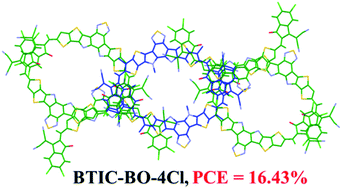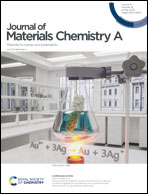Alkyl chain engineering of chlorinated acceptors for elevated solar conversion†
Abstract
Alkyl chain engineering has been widely applied in the preparation of high-performance organic solar energy conversion materials. In this study, a series of high-performance acceptor–donor–acceptor–donor–acceptor non-fullerene acceptors (NFAs) with core units functionalized with different alkyl chains (1-dodecyl, 2-ethylhexyl, 2-butyloctyl, and 2-hexyldecyl) and chlorinated end groups were designed and synthesized. All these molecules exhibited strong and broad absorption from 600 nm to 950 nm, low band gaps (1.34–1.39 eV), and high electron mobility. Furthermore, the single crystal of BTIC-BO-4Cl was successfully grown. The analysis of the single crystal revealed that this molecule formed a three-dimensional (3D) interpenetrating network due to multiple strong and short S⋯O, Cl⋯S, and Cl⋯π interactions among the adjacent BTIC-BO-4Cl molecules. This 3D interpenetrating network would definitely be beneficial for the transport of charge carriers and thus increase the electron mobility of the corresponding acceptor. When blended with the donor polymer PBDB-TF, it was found that the chlorinated non-fullerene acceptor with 2-butyloctyl-substituted side chains at the N positions displayed the highest device performance with a power conversion efficiency (PCE) of 16.43% among those acceptors. Our study demonstrates that the use of branched alkyl chains on nitrogen atoms is beneficial for the high efficiency of the core unit compared to those with linear chains, and the size of branched alkyl chains also has great effects on the resultant material and the corresponding device performance.

- This article is part of the themed collection: Journal of Materials Chemistry A Lunar New Year collection 2021


 Please wait while we load your content...
Please wait while we load your content...
